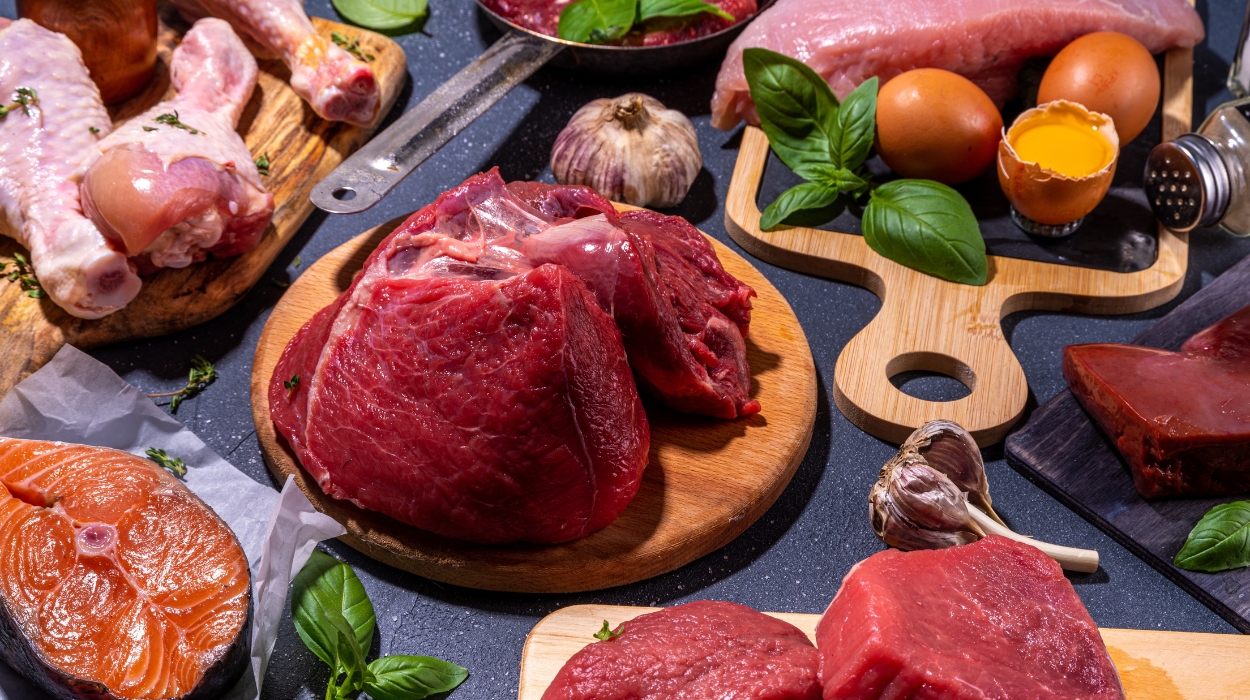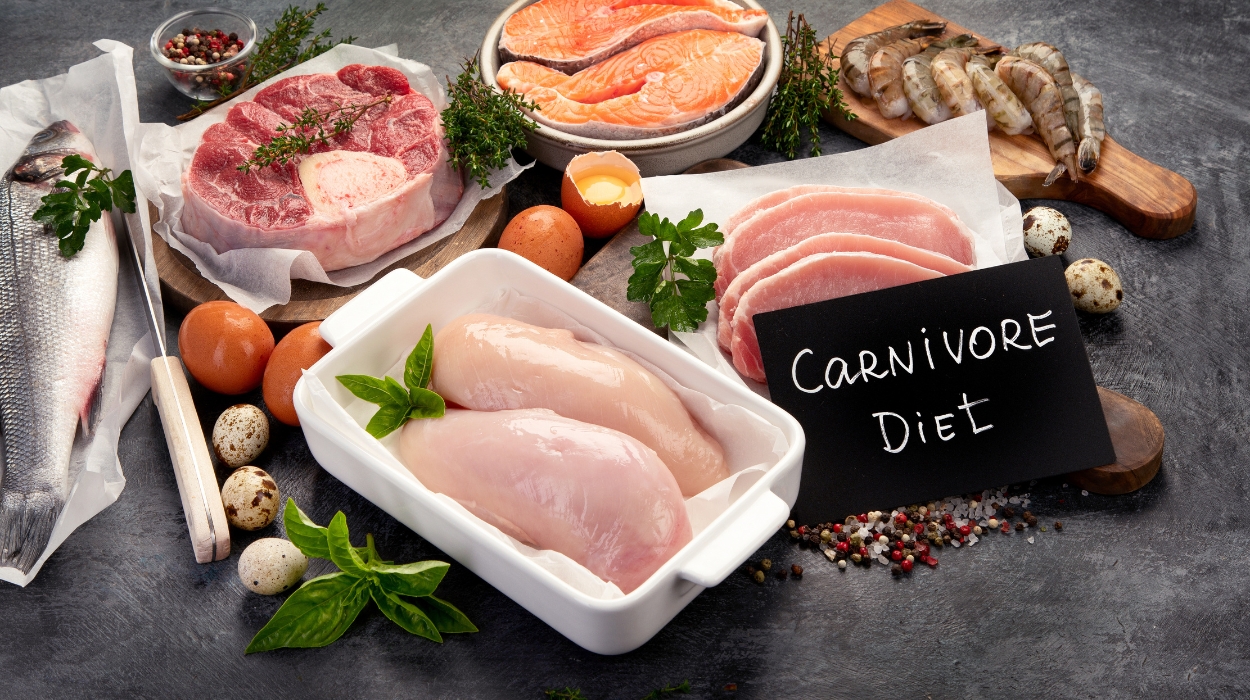 Expert's opinion
Expert's opinion
Expert's opinion
The article is a subjective view on this topic written by writers specializing in medical writing.
It may reflect on a personal journey surrounding struggles with an illness or medical condition, involve product comparisons, diet considerations, or other health-related opinions.
Although the view is entirely that of the writer, it is based on academic experiences and scientific research they have conducted; it is fact-checked by a team of degreed medical experts, and validated by sources attached to the article.
The numbers in parenthesis (1,2,3) will take you to clickable links to related scientific papers.
Carnivore Diet Meal Plan: Food List & Beginner’s Guide In 2024

Of the many weight loss diets, is the carnivore diet effective?
Here we highlight what a carnivore diet meal plan entails and how to add it to your new menu. This comprehensive guide will teach you about adopting a carnivorous lifestyle and reaping its benefits.
If you want to lose weight and improve body composition, keep reading to discover this high-protein diet‘s incredible potential!
Seven-Day Sample Menu For The Carnivore Diet Plan
Sample Carnivore Diet Meal Plan
Day 1: Steak And Egg Delight (approx. 1,751 calories)
Enjoy the rich, savory flavors of ribeye steak and eggs cooked in nourishing tallow. This high-protein breakfast provides sustained energy and essential nutrients for a strong start to your carnivore journey. Lunch features grilled chicken and bacon, providing protein and healthy fats, while dinner offers salmon and liver pâté for a nutrient-packed meal to support overall health.
| Breakfast | |
| Ribeye steak cooked in tallow | Eight ounces |
| Eggs cooked in tallow | Two large eggs |
| Lunch | |
| Grilled shredded chicken | Six ounces |
| Bacon | Four slices |
| Dinner | |
| Pan-seared salmon with butter | Six ounces |
| Liver pâté | Two ounces |
Day 2: Variety Of Meat Medley (approx. 1,965 calories)
Day two emphasizes the power of protein. Scrambled eggs with ground beef make a hearty and satisfying breakfast, and lamb chops for lunch provide a protein punch. Dinner includes roast duck with crispy skin and bone marrow, giving you an abundance of nutrients and essential fats for energy.
| Breakfast | |
| Ground beef cooked in beef fat | Six ounces |
| Scrambled eggs | Two large eggs |
| Lunch | |
| Lamb chops | Eight ounces |
| Bone broth | One cup |
| Dinner | |
| Roast duck with crispy skin | Eight ounces |
| Bone marrow | Two ounces |
Day 3: Pork And Organ Feast (approx. 1,560 calories)
Variety and vitality are key on day three. Pork belly strips and fried eggs offer a delicious and filling morning meal. Beef liver and sautéed onions at lunch provide a nutrient boost, and grilled shrimp with butter and beef bone broth for dinner ensures you get essential nutrients for overall well-being.
| Breakfast | |
| Pork belly strips | Six ounces |
| Fried eggs | Two large eggs |
| Lunch | |
| Beef liver with sautéed onions | Six ounces |
| Dinner | |
| Grilled shrimp with melted butter | Eight ounces |
| Beef bone broth | One cup |
Day 4: Bison And Beef Bonanza (approx. 1,985 calories)
Day four celebrates bison, a lean and flavorful meat choice. Bison steak with eggs for breakfast provides an excellent source of protein, while braised grass-fed beef short ribs with chicken wings offer a satisfying lunch. Oven-roasted turkey leg with homemade bone broth for dinner keeps you nourished and satisfied.
| Breakfast | |
| Bison steak | Eight ounces |
| Sunny-side-up eggs | Two large eggs |
| Lunch | |
| Braised grass-fed beef short ribs | Eight ounces |
| Beef tallow-fried chicken wings | Six wings |
| Dinner | |
| Oven-roasted turkey leg | Eight ounces |
| Homemade bone broth | One cup |
Day 5: Sausage And Pork Palate (approx. 1,990 calories)
Sausage patties and scrambled eggs cooked in lard make for a delicious and indulgent breakfast. Lunch features pork chops and bacon-wrapped asparagus, delivering a satisfying combination of protein and fats. Grilled sardines with lemon butter sauce and beef heart in the evening provide omega-3s and nutrients for optimal health.
| Breakfast | |
| Sausage patties cooked in lard | Six ounces |
| Scrambled eggs cooked in lard | Two large eggs |
| Lunch | |
| Pork chops | Eight ounces |
| Bacon-wrapped asparagus | Five spears |
| Dinner | |
| Grilled sardines with lemon butter sauce | Six ounces |
| Beef heart | Four ounces |
Day 6: Game Meat Galore (approx. 1,960 calories)
Day six is all about venison, a lean and protein-rich meat. Venison steak with fried eggs in the morning sets the tone. Ground beef burger patties and bone broth at lunch ensure you stay satisfied, and pan-seared chicken livers with caramelized onions at dinner offer a flavorful and nutritious meal.
| Breakfast | |
| Venison steak | Eight ounces |
| Fried eggs | Two large eggs |
| Lunch | |
| Ground beef burger patties | Two patties |
| Bone broth | One cup |
| Dinner | |
| Pan-seared chicken livers with caramelized onions | Eight ounces |
Day 7: Lamb And Poultry Extravaganza (approx. 2,370 calories)
he final day features the luxury of duck confit with sunny-side-up quail eggs for breakfast. Ribeye steak with crispy pork rinds at lunch provides a satisfying combination of flavors and textures. In the evening, grilled lamb skewers with bone marrow add a delicious and nutrient-rich touch to your carnivore journey.
| Breakfast | |
| Duck confit | Eight ounces |
| Sunny-side-up quail eggs | Four eggs |
| Lunch | |
| Ribeye steak | Eight ounces |
| Crispy pork rinds | One ounce |
| Dinner | |
| Grilled lamb skewers | Eight ounces |
| Bone marrow | Two ounces |
With this carnivore diet menu, you can rotate the meals, and it’s unlikely that you will need protein powder as this diet is very high in protein. Because of the reduction of certain vital minerals, you should consider supplementing. Magnesium supplements are highly recommended since red meat lacks[1] nutrients. You may also twerk the menu by adding fruits to create a carnivore diet with a fruit meal plan.
It’s always recommended to consult with a registered dietitian before starting any new elimination diet, particularly with carnivore diet meal plans with such a high protein intake.
What Is The Carnivore Diet?

A carnivore diet focuses exclusively on animal-based foods. It involves consuming only animal products, including meat, poultry, organ meats, and animal fats. This diet excludes plant-based foods and processed items. It prioritizes high protein and healthy fat intake while minimizing carbohydrate intake.
Advocates of the carnivore diet claim that it can lead to significant weight loss, improved body composition, and enhanced overall health. By eliminating potentially problematic foods, such as grains, legumes, and processed sugars, this diet aims to optimize digestion, increase energy levels, and promote mental clarity.
Benefits Of The Carnivore Diet
Here are some benefits of a carnivore diet:
- Weight Loss: The carnivore diet may promote weight loss[2] in some people with type 2 diabetes by reducing carbohydrate intake. This low-carb intake leads to decreased insulin levels and increased fat burning.
- Increased Satiety: Proteins and other animal foods are often more satiating[3] due to their high protein content. This reduces hunger and improves portion control.
- Enhanced Mental Clarity: You may also notice improved mental clarity and focus after following the carnivore diet. This is likely due to the absence of potential brain fog-inducing foods like added sugars. Also, lacking meat could lead to anxiety and depression.[4]
- Reduced Inflammation: By eliminating processed foods[5] and the potential inflammatory triggers, the carnivore diet may help reduce inflammation in the body.
- Allergen Elimination: The carnivorous diet helps avoid common allergens like gluten and full-fat dairy if avoiding lactose or casein.
Carnivore Diet Food List
Here is a carnivore diet food list you can enjoy while adhering to a carnivore diet plan.
Meat And Poultry
Choose from various types of meat, including beef, pork, lamb, and poultry, such as chicken and turkey. You may also add a few fatty cuts like ribeye or t-bone steak, bacon, and chicken thighs, as they provide ample protein[6] sources.
Satiety,[7] the satisfaction you experience after a meal, is important for weight loss[8] because it helps control hunger and prevents overeating. Studies show that eating more high-quality lean meats, such as grass-fed meat, may increase satiety and support weight loss.[9]
Organ Meats
Include nutrient-dense organ meats in your diet, such as the liver, heart, and kidneys. These powerhouse foods are rich in vitamins, minerals, and essential nutrients like vitamin B12,[10] bioavailable iron,[11] and zinc.
These vitamins are coenzymes supporting energy production,[12] immune function,[13] and cellular processes.[14] Iron is essential for oxygen transport[15] and energy production, while zinc aids immune function[16] and wound healing.[17] Minerals like calcium and magnesium are crucial for bone health,[18] nerve function,[19] and metabolism.[20]
Bone Broth

Sip on a nourishing bone broth from simmering animal bones. It’s packed with collagen and beneficial amino acids and might promote gut health and joint support.
Collagen[21] is a protein that provides structural support to connective tissues, improving skin, joints, and cartilage. Essential amino acids like glycine enhance sleep;[22] proline and hydroxyproline aid collagen production[23] in connective tissue formation and repair. Glutamine supports the gut[24] and immune system. These nutrients contribute to skin health, joint function, digestion, and well-being.
Studies suggest that collagen proteins can be a good source of glycine.[25] However, homemade bone broth is not a reliable source of collagen[26] or amino acids. So don’t rely on it for all your collagen needs.
Animal Fats
Add animal fats like beef tallow, lard, and duck fat to your food. These healthy fats add incredible flavor to your meals. Some animal fats, such as tallow, can provide fatty acids, including omega-3 and omega-6,[27] important for brain function[28] and overall human health.
Please note that concentrated animal fats are high in saturated fat[29] and should be consumed in moderation.
Dairy And Eggs
While some carnivore dieters avoid dairy, others include high-fat low-lactose dairy products like butter and cheese. Eggs are a rich source of high-quality protein supporting muscle growth.[30] Dairy products[31] contain calcium, vitamin D, and protein, contributing to strong bones, healthy teeth,[32] and optimal growth.
Seafood
You may also include seafood like fish, shrimp, and shellfish. These provide marine omega-3 fatty acids that are excellent for heart health,[33] brain function,[34] and reducing inflammation.[35]
What Foods To Avoid?
When following the carnivore diet meal plan for weight loss, the central focus is to eat animal foods. Second, you eliminate plant-based products and follow an almost zero-carb diet – similar to a keto diet. Here are some key food categories to avoid:
Plant-Based Foods
Eliminate all fruits, vegetables, grains, legumes, and other plant-based foods from your diet. This includes avoiding bananas, broccoli, rice, lentils, and beans.
Also, eliminate all grains and cereals, including wheat, oats, barley, and rice. These contain high levels of carbohydrates and antinutrients that may disrupt digestion.
By eliminating most plant-based foods, the carnivore diet aims to promote ketosis.[36] Ketosis is a metabolic state where the body burns body fat for fuel instead of carbohydrates. It is achieved by following a high-fat, low-carb keto diet.
Processed Foods
Avoid processed foods such as chips, cookies, candies, and other packaged snacks. These typically contain additives, preservatives, and high levels of carbohydrates.
Sugars And Sweeteners
Avoid all sugars and sweeteners, including table sugar, honey, maple syrup, and artificial sweeteners. These can decrease insulin sensitivity[37] and hinder the metabolic state desired in the carnivore diet. When insulin sensitivity decreases, it elevates insulin levels, contributing to insulin resistance and metabolic dysfunction.[38]
Beverages
Avoid sugary drinks, fruit juices, sodas, and alcohol. Stick to water, coffee, or tea without additives or sweeteners.
Highly Processed Meats
Limit highly processed meats like sausages, hot dogs, and deli meats for a strict carnivore diet meal plan. Opt for unprocessed, whole cuts of meat whenever possible.
What Are The Risks?
A carnivore meal plan may be a healthy diet, but are there any risks? As with most restrictive diets, there are some risks related to the all-meat diet. Here are the ones you should be aware of.
- Nutrient Deficiencies: Eliminating entire food groups may increase the risk of nutrient deficiencies.[2] Meat-eaters are at risk of deficiencies in essential nutrients, including omega-3 fatty acids, calcium, and magnesium.[39] Low-carb diets may cause deficiencies[40] in vitamin C, potassium, and other phytochemicals found in a vegan diet.
- Limited Fiber Intake: The absence of fiber[41] from plant foods can disrupt healthy bowel movements. It may also increase the risk of gastrointestinal conditions such as colon cancer.[42]
- Potential Increase In Saturated Fat: Eating foods high in animal fats may lead to elevated saturated fat levels depending on food choices. This potentially contributes to heart disease risks.[43]
- Lack Of Antioxidants: Eating habits that exclude plant foods result in a lower intake of antioxidants. Antioxidants help combat oxidative stress and reduce the risk of chronic diseases.[44]
- Altered Gut Microbiome: Limited fiber intake can negatively affect the diversity[45] and composition of the gut microbiome, which plays a crucial role in overall health and well-being.
The Bottom Line
The carnivore diet offers potential health benefits such as weight loss, improved insulin sensitivity, and increased satiety. However, it is not without its risks.
Nutrient deficiencies, limited fiber intake, increased saturated fat intake, missing antioxidants, and altered gut microbiome are some concerns to consider. So it is crucial to approach this mostly-meat diet cautiously, ensuring proper nutrient balance and monitoring overall health. You may consider dietary weight loss supplements for the nutrients you are missing to complete a balanced diet.
You can customize the diet however you want, even seeking a strict carnivore diet meal plan online. All in all, the final say should be from a healthcare professional or registered dietitian. These experts help you navigate potential risks and meet individualized nutritional needs for carnivore diets. While some people find it okay to eat meat daily, you should still carefully evaluate its long-term sustainability and overall health implications.
+ 45 sources
Health Canal avoids using tertiary references. We have strict sourcing guidelines and rely on peer-reviewed studies, academic researches from medical associations and institutions. To ensure the accuracy of articles in Health Canal, you can read more about the editorial process here
- Cazzola, R., Matteo Della Porta, Manoni, M., Stefano Iotti, Pinotti, L. and Jeanette (2020). Going to the roots of reduced magnesium dietary intake: A tradeoff between climate changes and sources. Heliyon, [online] 6(11), pp.e05390–e05390. doi:https://doi.org/10.1016/j.heliyon.2020.e05390.
- Lennerz, B., Mey, J.T., Henn, O.H. and Ludwig, D.S. (2021). Behavioral Characteristics and Self-Reported Health Status among 2029 Adults Consuming a ‘Carnivore Diet’. Current Developments in Nutrition, [online] 5(12), pp.nzab133–nzab133. doi:https://doi.org/10.1093/cdn/nzab133.
- Rica, N., Hanne Christine Bertram, Heddie Mejborn, Lars Ove Dragsted, Kristensen, L., Jorge Ruiz Carrascal, Bügel, S. and Astrup, A. (2021). Meat and Human Health—Current Knowledge and Research Gaps. Foods, [online] 10(7), pp.1556–1556. doi:https://doi.org/10.3390/foods10071556.
- Urska Dobersek, Wy, G.C., Adkins, J., Altmeyer, S., Krout, K., Lavie, C.J. and Archer, E. (2020). Meat and mental health: a systematic review of meat abstention and depression, anxiety, and related phenomena. Critical Reviews in Food Science and Nutrition, [online] 61(4), pp.622–635. doi:https://doi.org/10.1080/10408398.2020.1741505.
- Martins, S., Karina, A., Cristina, Abreu, C., Danielle, K., Miranda, Mônica Araújo Batalha, Daniel and Costa, C. (2021). Intake of ultra-processed foods is associated with inflammatory markers in Brazilian adolescents. Public Health Nutrition, [online] 25(3), pp.591–599. doi:https://doi.org/10.1017/s1368980021004523.
- Lonnie, M., Hooker, E., Jeffrey Michael Brunstrom, Corfe, B.M., Green, M.A., Watson, A., Williams, E.A., Stevenson, E., Penson, S. and Johnstone, A.M. (2018). Protein for Life: Review of Optimal Protein Intake, Sustainable Dietary Sources and the Effect on Appetite in Ageing Adults. Nutrients, [online] 10(3), pp.360–360. doi:https://doi.org/10.3390/nu10030360.
- Forde, C.G., Almíron-Roig, E. and Jeffrey Michael Brunstrom (2015). Expected Satiety: Application to Weight Management and Understanding Energy Selection in Humans. Current Obesity Reports, [online] 4(1), pp.131–140. doi:https://doi.org/10.1007/s13679-015-0144-0.
- Leidy, H.J., Clifton, P., Astrup, A., Wycherley, T.P., Westerterp-Plantenga, M.S., Luscombe-Marsh, N.D., Woods, S.C. and Mattes, R.D. (2015). The role of protein in weight loss and maintenance. The American Journal of Clinical Nutrition, [online] 101(6), pp.1320S1329S. doi:https://doi.org/10.3945/ajcn.114.084038.
- Wyness, L. (2015). The role of red meat in the diet: nutrition and health benefits. Proceedings of the Nutrition Society, [online] 75(3), pp.227–232. doi:https://doi.org/10.1017/s0029665115004267.
- Obeid, R., Heil, S.G., Verhoeven, M.M.A., Ellen, Lisette and Simone (2019). Vitamin B12 Intake From Animal Foods, Biomarkers, and Health Aspects. Frontiers in Nutrition, [online] 6. doi:https://doi.org/10.3389/fnut.2019.00093.
- Mateusz Buzała, Artur Słomka and Janicki, B. (2016). Heme iron in meat as the main source of iron in the human diet. [online] ResearchGate. Available at: https://www.researchgate.net/publication/285360815_Heme_iron_in_meat_as_the_main_source_of_iron_in_the_human_diet.
- Anne Laure Tardy, Etienne Pouteau, Márquez, D., Çetin Yılmaz and Scholey, A. (2020). Vitamins and Minerals for Energy, Fatigue and Cognition: A Narrative Review of the Biochemical and Clinical Evidence. Nutrients, [online] 12(1), pp.228–228. doi:https://doi.org/10.3390/nu12010228.
- Mitra, S., Paul, S., Roy, S., Hriday Sutradhar, Talha Bin Emran, Firzan Nainu, Mayeen Uddin Khandaker, Almalki, M., Polrat Wilairatana and Mubarak, M.S. (2022). Exploring the Immune-Boosting Functions of Vitamins and Minerals as Nutritional Food Bioactive Compounds: A Comprehensive Review. Molecules, [online] 27(2), pp.555–555. doi:https://doi.org/10.3390/molecules27020555.
- Schnellbaecher, A., Binder, D., Bellmaine, S. and Zimmer, A. (2019). Vitamins in cell culture media: Stability and stabilization strategies. Biotechnology and Bioengineering, [online] 116(6), pp.1537–1555. doi:https://doi.org/10.1002/bit.26942.
- Abbaspour, N., Hurrell, R. and Kelishadi, R. (2014). Review on iron and its importance for human health. Journal of research in medical sciences : the official journal of Isfahan University of Medical Sciences, [online] 19(2), pp.164–74. Available at: https://www.ncbi.nlm.nih.gov/pmc/articles/PMC3999603/.
- Haase, H. and Rink, L. (2014). Multiple impacts of zinc on immune function. Metallomics, [online] 6(7), pp.1175–1175. doi:https://doi.org/10.1039/c3mt00353a.
- Lin, P., Sermersheim, M., Li, H., Peter H.U. Lee, Steinberg, S.M. and Ma, J. (2017). Zinc in Wound Healing Modulation. Nutrients, [online] 10(1), pp.16–16. doi:https://doi.org/10.3390/nu10010016.
- Mariangela Rondanelli, Milena Anna Faliva, Tartara, A., Gasparri, C., Perna, S., Infantino, V., Riva, A., Petrangolini, G. and Peroni, G. (2021). An update on magnesium and bone health. BioMetals, [online] 34(4), pp.715–736. doi:https://doi.org/10.1007/s10534-021-00305-0.
- Kirkland, A.E., Sarlo, G.L. and Holton, K.F. (2018). The Role of Magnesium in Neurological Disorders. Nutrients, [online] 10(6), pp.730–730. doi:https://doi.org/10.3390/nu10060730.
- Moore‐Schiltz, L., Albert, J.M., Singer, M.E., Swain, J.H. and Nock, N.L. (2015). Dietary intake of calcium and magnesium and the metabolic syndrome in the National Health and Nutrition Examination (NHANES) 2001–2010 data. British Journal of Nutrition, [online] 114(6), pp.924–935. doi:https://doi.org/10.1017/s0007114515002482.
- Wang, H. (2021). A Review of the Effects of Collagen Treatment in Clinical Studies. Polymers, [online] 13(22), pp.3868–3868. doi:https://doi.org/10.3390/polym13223868.
- Kawai, N., Sakai, N., Masashi Okuro, Sachie Karakawa, Yosuke Tsuneyoshi, Kawasaki, N., Takeda, T., Makoto Bannai and Nishino, S. (2014). The Sleep-Promoting and Hypothermic Effects of Glycine are Mediated by NMDA Receptors in the Suprachiasmatic Nucleus. Neuropsychopharmacology, [online] 40(6), pp.1405–1416. doi:https://doi.org/10.1038/npp.2014.326.
- Albaugh, V.L., Mukherjee, K. and Barbul, A. (2017). Proline Precursors and Collagen Synthesis: Biochemical Challenges of Nutrient Supplementation and Wound Healing. The Journal of Nutrition, [online] 147(11), pp.2011–2017. doi:https://doi.org/10.3945/jn.117.256404.
- Perna, S., Alalwan, T.A., Zahraa Alaali, Tahera Alnashaba, Gasparri, C., Infantino, V., Hammad, L., Riva, A., Petrangolini, G., Allegrini, P. and Mariangela Rondanelli (2019). The Role of Glutamine in the Complex Interaction between Gut Microbiota and Health: A Narrative Review. International Journal of Molecular Sciences, [online] 20(20), pp.5232–5232. doi:https://doi.org/10.3390/ijms20205232.
- Alcock, R.D., Shaw, G., Tee, N. and Burke, L.M. (2019). Plasma Amino Acid Concentrations After the Ingestion of Dairy and Collagen Proteins, in Healthy Active Males. Frontiers in Nutrition, [online] 6. doi:https://doi.org/10.3389/fnut.2019.00163.
- Alcock, R.D., Shaw, G. and Burke, L.M. (2019). Bone Broth Unlikely to Provide Reliable Concentrations of Collagen Precursors Compared With Supplemental Sources of Collagen Used in Collagen Research. International Journal of Sport Nutrition and Exercise Metabolism, [online] 29(3), pp.265–272. doi:https://doi.org/10.1123/ijsnem.2018-0139.
- Margarette, K., Bin, S., Shin, S., Lee, Y., Xiang Zi Li, Xiang Zi Li and Park, S. (2022). Fatty Acid Composition of Grain- and Grass-Fed Beef and Their Nutritional Value and Health Implication. Food Science of Animal Resources, [online] 42(1), pp.18–33. doi:https://doi.org/10.5851/kosfa.2021.e73.
- Dighriri, I.M., Alsubaie, A.M., Hakami, F.M., Dalal Hamithi, Maryam Mohammed Alshekh, Khobrani, F.A., Dalak, F.E., Hakami, A.A., Alsueaadi, E.H., Alsaawi, L.S., Alshammari, S.F., Alqahtani, A.S., Alawi, I.A., Aljuaid, A.A. and Tawhari, M.Q. (2022). Effects of Omega-3 Polyunsaturated Fatty Acids on Brain Functions: A Systematic Review. Cureus. [online] doi:https://doi.org/10.7759/cureus.30091.
- Usda.gov. (2024). FoodData Central. [online] Available at: https://fdc.nal.usda.gov/fdc-app.html#/food-details/171401/nutrients.
- Fuchs, C.J., Hermans, W.J.H., Smeets, J.S.J., Senden, J.M., Janneau van Kranenburg, Stefan H.M. Gorissen, Burd, N.A., Verdijk, L.B. and Loon, van (2022). Raw Eggs To Support Postexercise Recovery in Healthy Young Men: Did Rocky Get It Right or Wrong? The Journal of Nutrition, [online] 152(11), pp.2376–2386. doi:https://doi.org/10.1093/jn/nxac174.
- Górska-Warsewicz, H., Rejman, K., Laskowski, W. and Maksymilian Czeczotko (2019). Milk and Dairy Products and Their Nutritional Contribution to the Average Polish Diet. Nutrients, [online] 11(8), pp.1771–1771. doi:https://doi.org/10.3390/nu11081771.
- Blerina Shkembi and Thom Huppertz (2023). Impact of Dairy Products and Plant-Based Alternatives on Dental Health: Food Matrix Effects. Nutrients, [online] 15(6), pp.1469–1469. doi:https://doi.org/10.3390/nu15061469.
- Innes, J.K. and Calder, P.C. (2020). Marine Omega-3 (N-3) Fatty Acids for Cardiovascular Health: An Update for 2020. International Journal of Molecular Sciences, [online] 21(4), pp.1362–1362. doi:https://doi.org/10.3390/ijms21041362.
- Dae Hyun Kim, Grodstein, F., Rosner, B., Jae Hee Kang, Cook, N.R., Manson, J.E., Buring, J.E., Willett, W.C. and Okereke, O.I. (2013). Seafood Types and Age-Related Cognitive Decline in the Women’s Health Study. The Journals of Gerontology: Series A, [online] 68(10), pp.1255–1262. doi:https://doi.org/10.1093/gerona/glt037.
- Calder, P.C. (2015). Marine omega-3 fatty acids and inflammatory processes: Effects, mechanisms and clinical relevance. Biochimica et Biophysica Acta (BBA) – Molecular and Cell Biology of Lipids, [online] 1851(4), pp.469–484. doi:https://doi.org/10.1016/j.bbalip.2014.08.010.
- Miller, V., Villamena, F.A. and Volek, J.S. (2018). Nutritional Ketosis and Mitohormesis: Potential Implications for Mitochondrial Function and Human Health. Journal of Nutrition and Metabolism, [online] 2018, pp.1–27. doi:https://doi.org/10.1155/2018/5157645.
- Mathur, K., Rajat Kumar Agrawal, Shailesh Nagpure and Deshpande, D. (2020). Effect of artificial sweeteners on insulin resistance among type-2 diabetes mellitus patients. Journal of family medicine and primary care, [online] 9(1), pp.69–69. doi:https://doi.org/10.4103/jfmpc.jfmpc_329_19.
- Fahed, G., Aoun, L., Morgan Bou Zerdan, Allam, S., Maroun Bou Zerdan, Youssef Bouferraa and Assi, H. (2022). Metabolic Syndrome: Updates on Pathophysiology and Management in 2021. International Journal of Molecular Sciences, [online] 23(2), pp.786–786. doi:https://doi.org/10.3390/ijms23020786.
- Neufingerl, N. and Eilander, A. (2021). Nutrient Intake and Status in Adults Consuming Plant-Based Diets Compared to Meat-Eaters: A Systematic Review. Nutrients, [online] 14(1), pp.29–29. doi:https://doi.org/10.3390/nu14010029.
- Cordain, L. (2018). Nutritional Deficiencies of Ketogenic Diets. [online] ResearchGate. Available at: https://www.researchgate.net/publication/332098774_Nutritional_Deficiencies_of_Ketogenic_Diets.
- Shen, S., Kathryn Prame Kumar, Wen, S., Shim, R., Wanrooy, B.J., Stanley, D., Moore, R.J., Thu, T., Robert, R., Hickey, M.J. and Hoi, C. (2021). Deficiency of Dietary Fiber Modulates Gut Microbiota Composition, Neutrophil Recruitment and Worsens Experimental Colitis. Frontiers in Immunology, [online] 12. doi:https://doi.org/10.3389/fimmu.2021.619366.
- Yang, Y., Li, Y., Zhou, L. and Tang, S. (2021). A Critical Review of the Effect of Dietary Fiber Intake on the Prevention of Colorectal Cancer in Eastern Asian Countries. Journal of Healthcare Engineering, [online] 2021, pp.1–8. doi:https://doi.org/10.1155/2021/6680698.
- Maki, K.C., Dicklin, M.R. and Kirkpatrick, C.F. (2021). Saturated fats and cardiovascular health: Current evidence and controversies. Journal of Clinical Lipidology, [online] 15(6), pp.765–772. doi:https://doi.org/10.1016/j.jacl.2021.09.049.
- Małgorzata Elżbieta Zujko and Witkowska, A. (2023). Dietary Antioxidants and Chronic Diseases. Antioxidants, [online] 12(2), pp.362–362. doi:https://doi.org/10.3390/antiox12020362.
- Fu, J., Zheng, Y., Gao, Y. and Wang, X. (2022). Dietary Fiber Intake and Gut Microbiota in Human Health. Microorganisms, [online] 10(12), pp.2507–2507. doi:https://doi.org/10.3390/microorganisms10122507.



